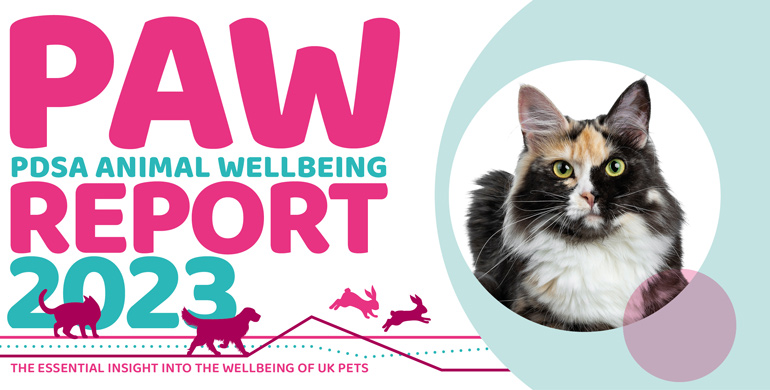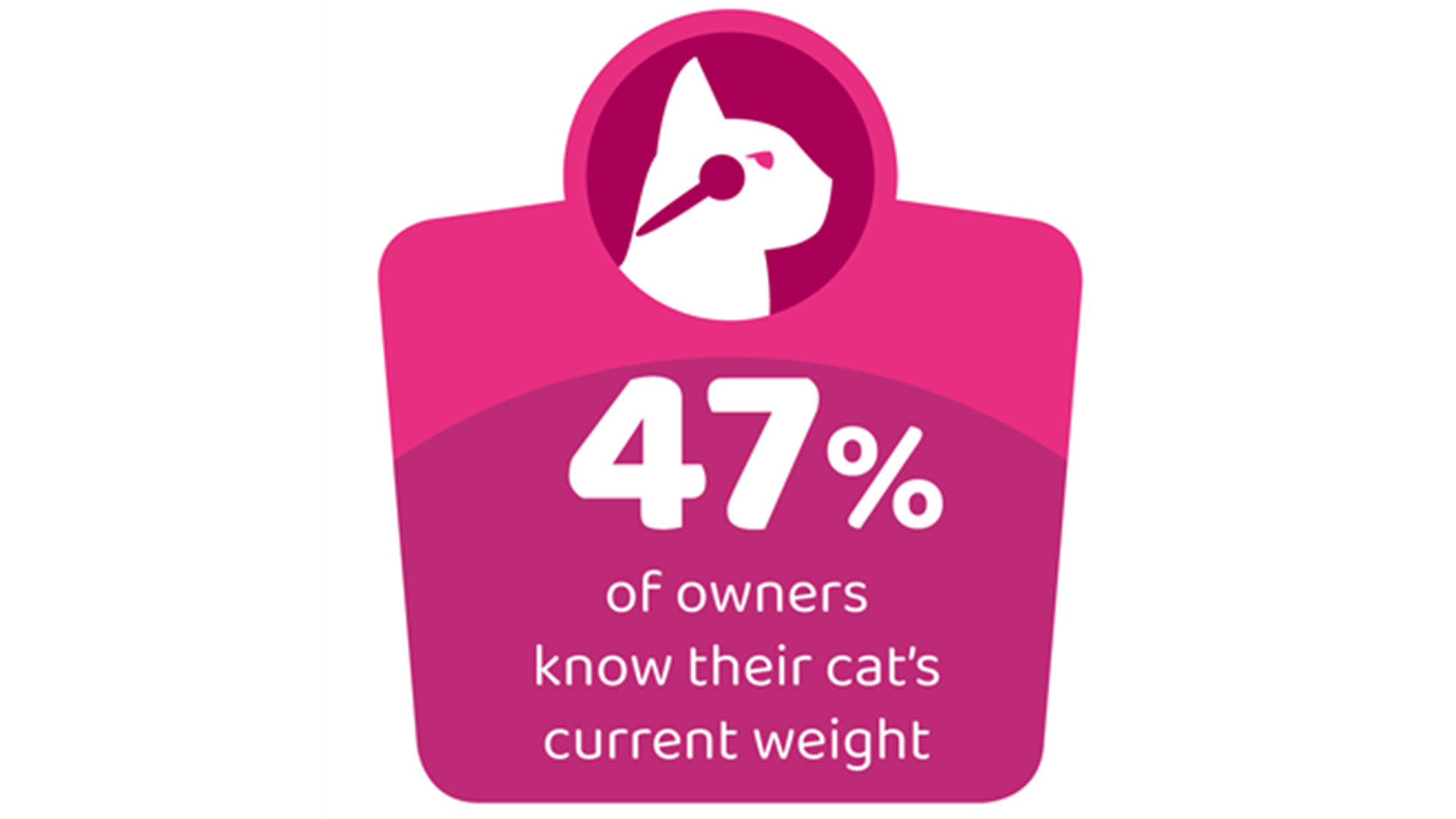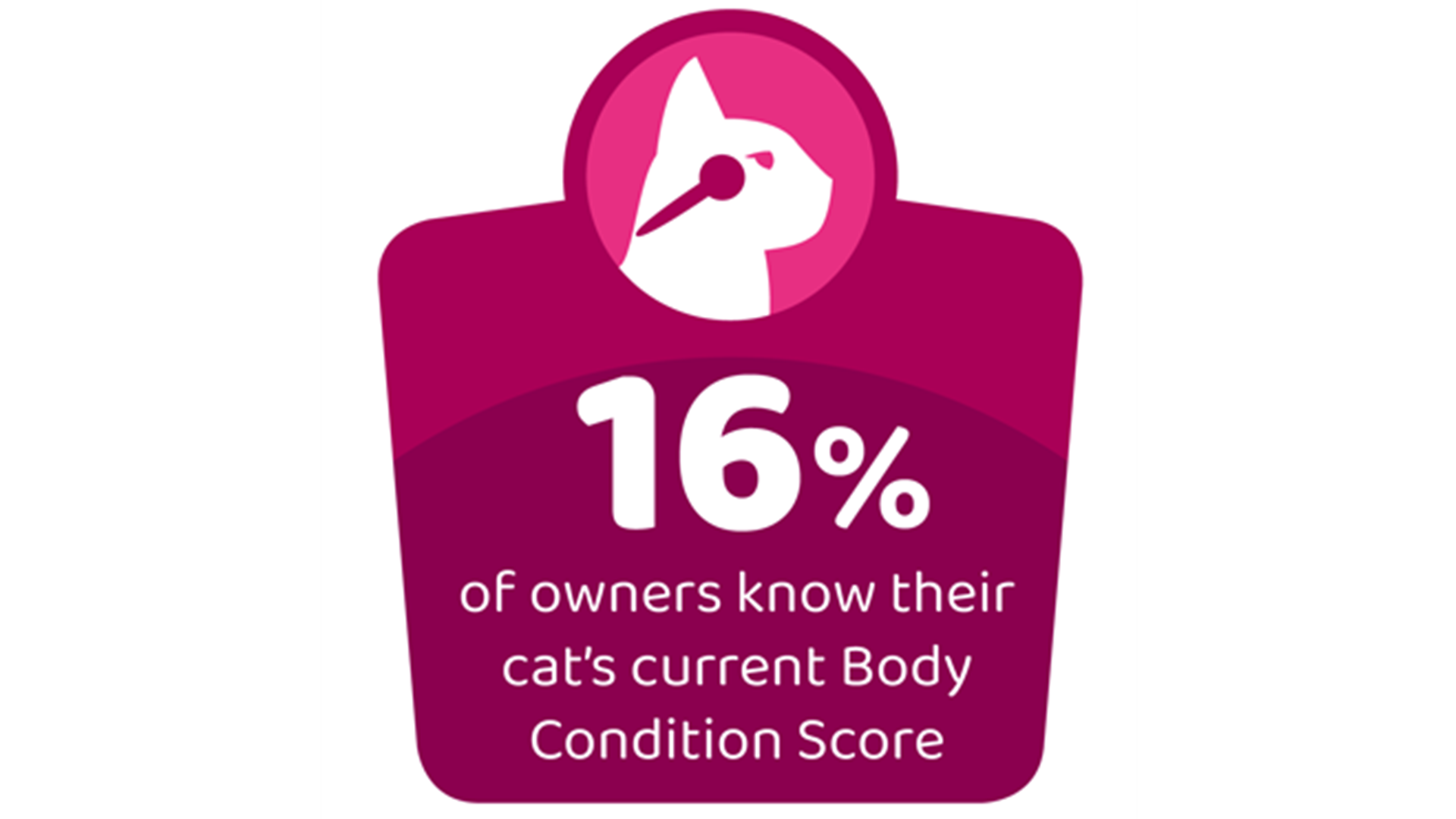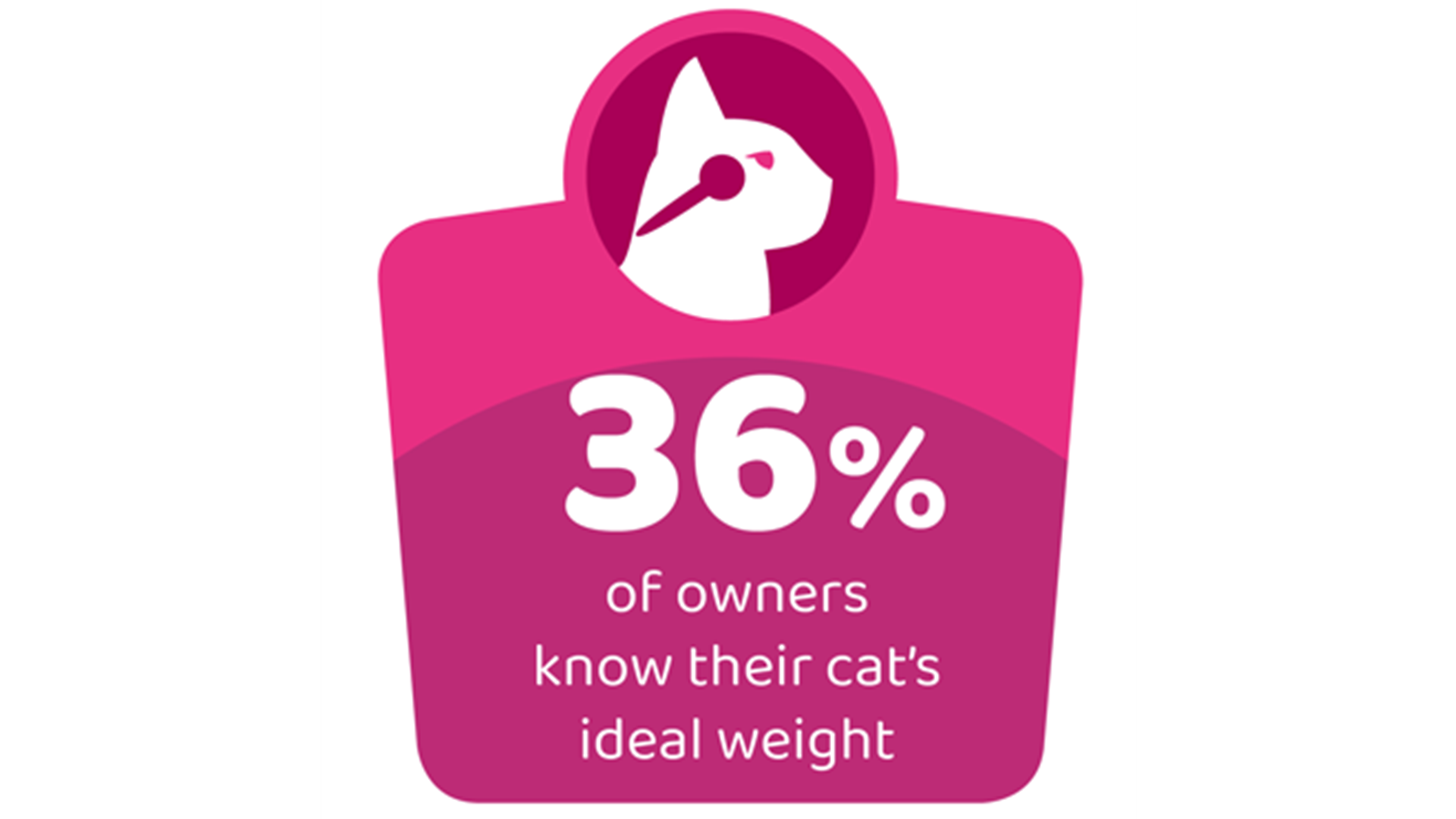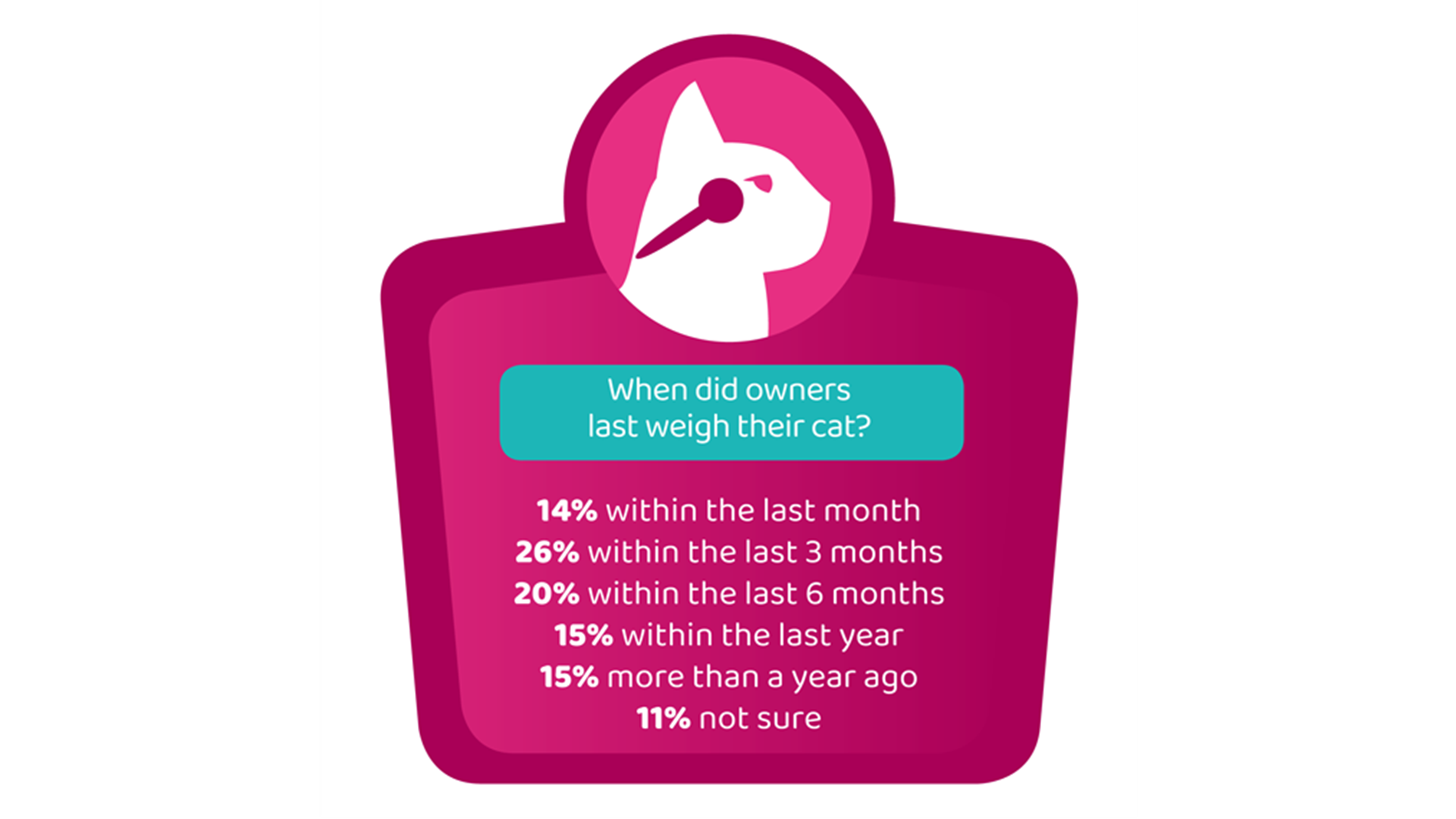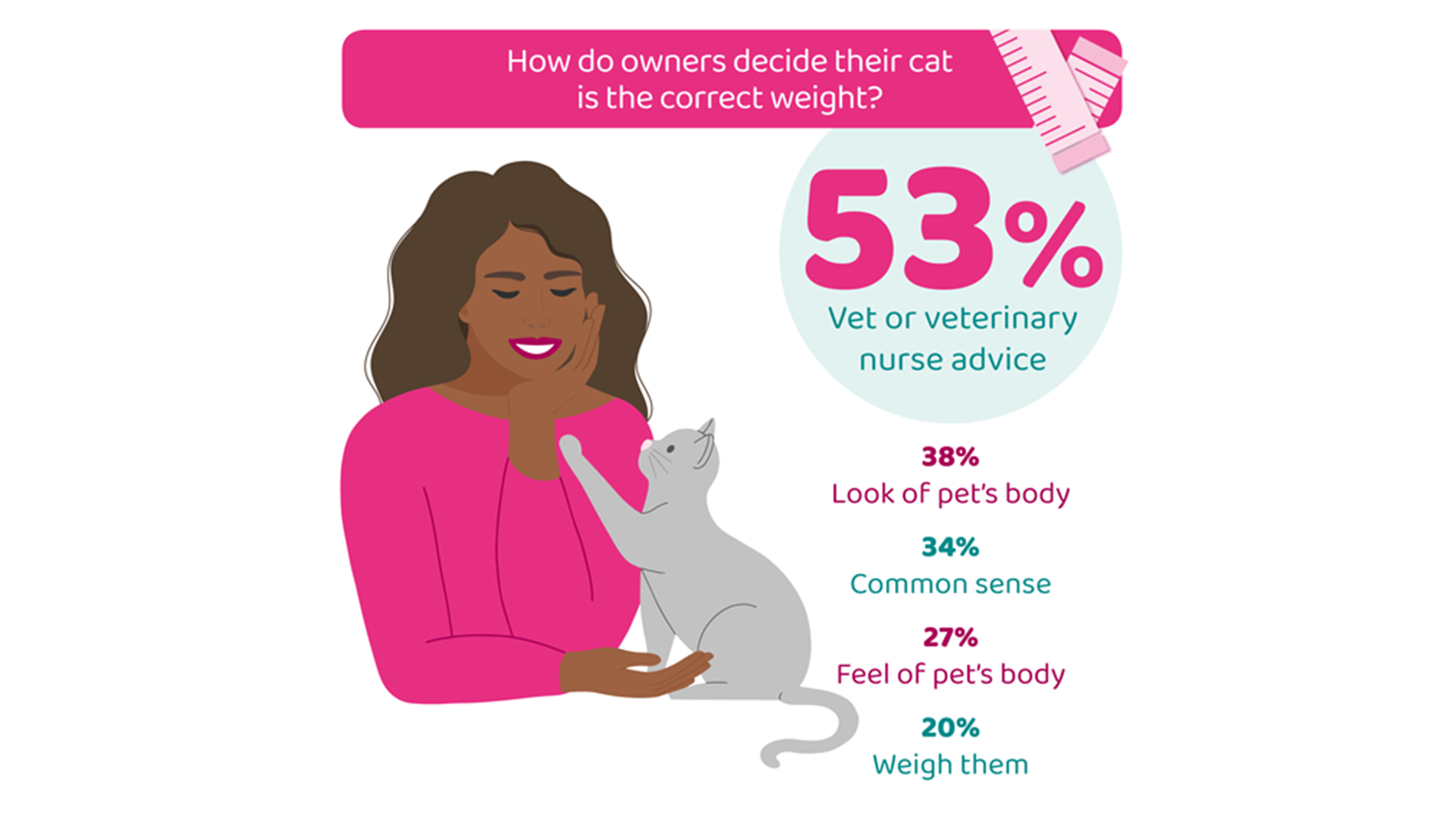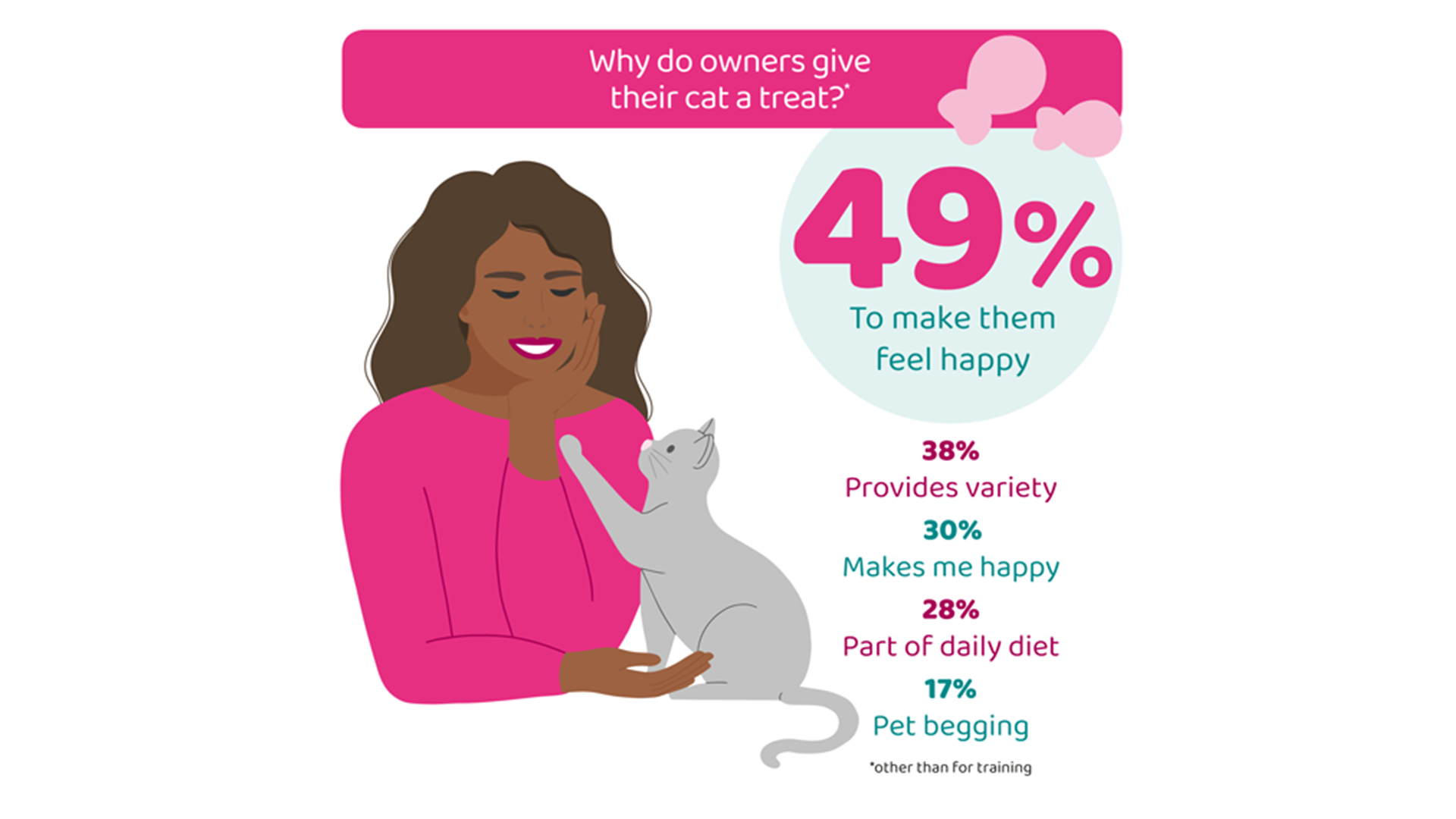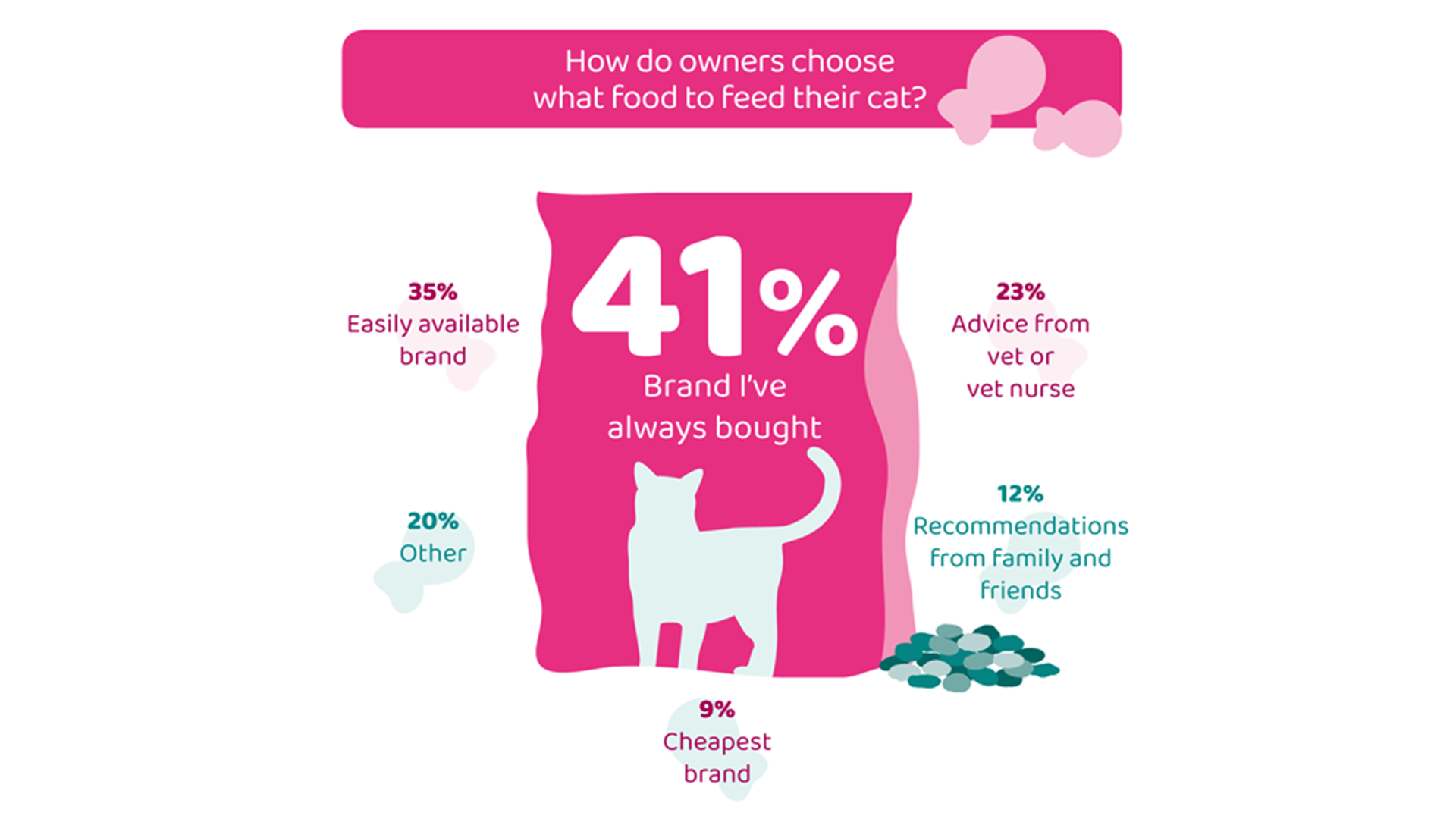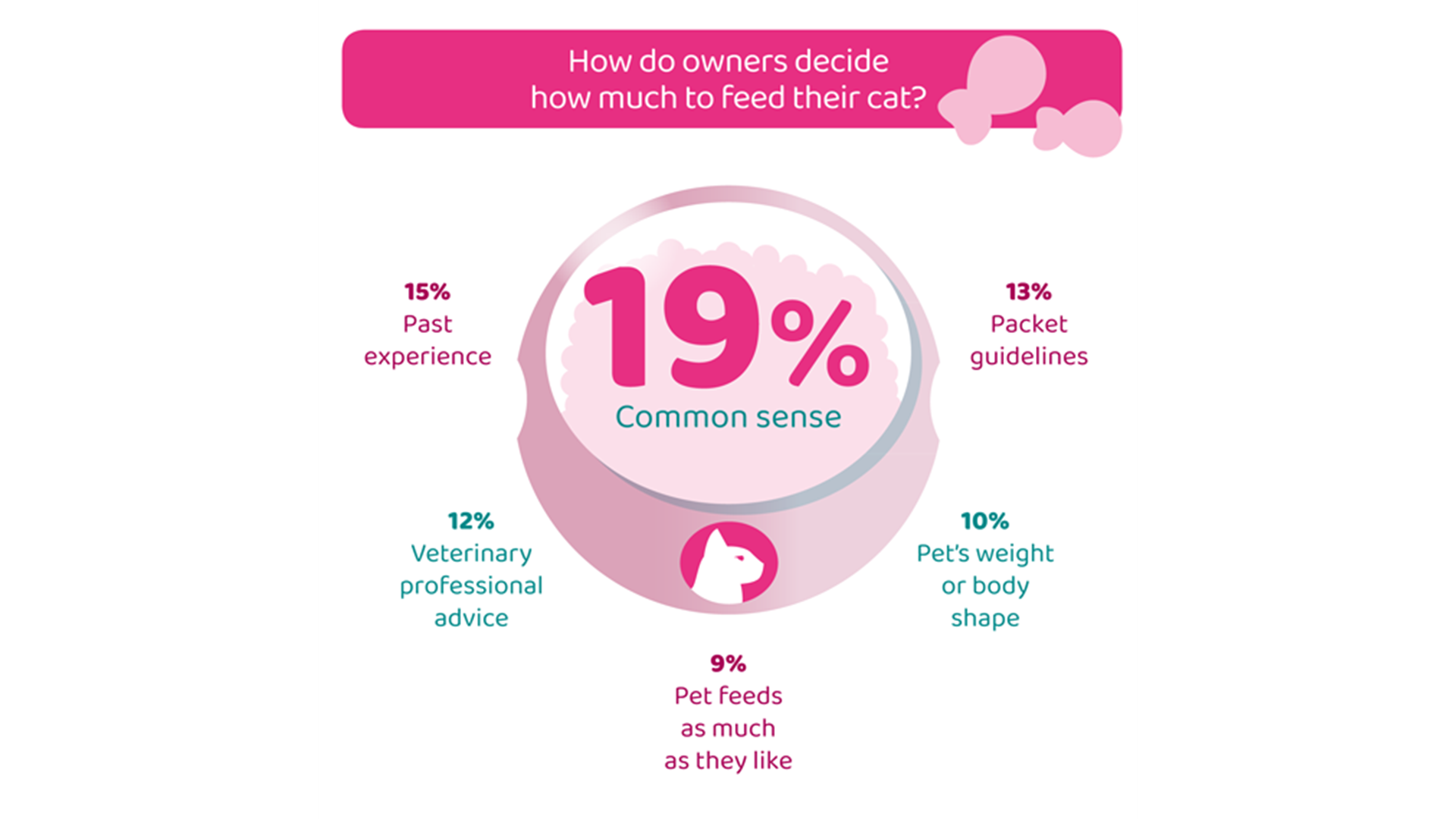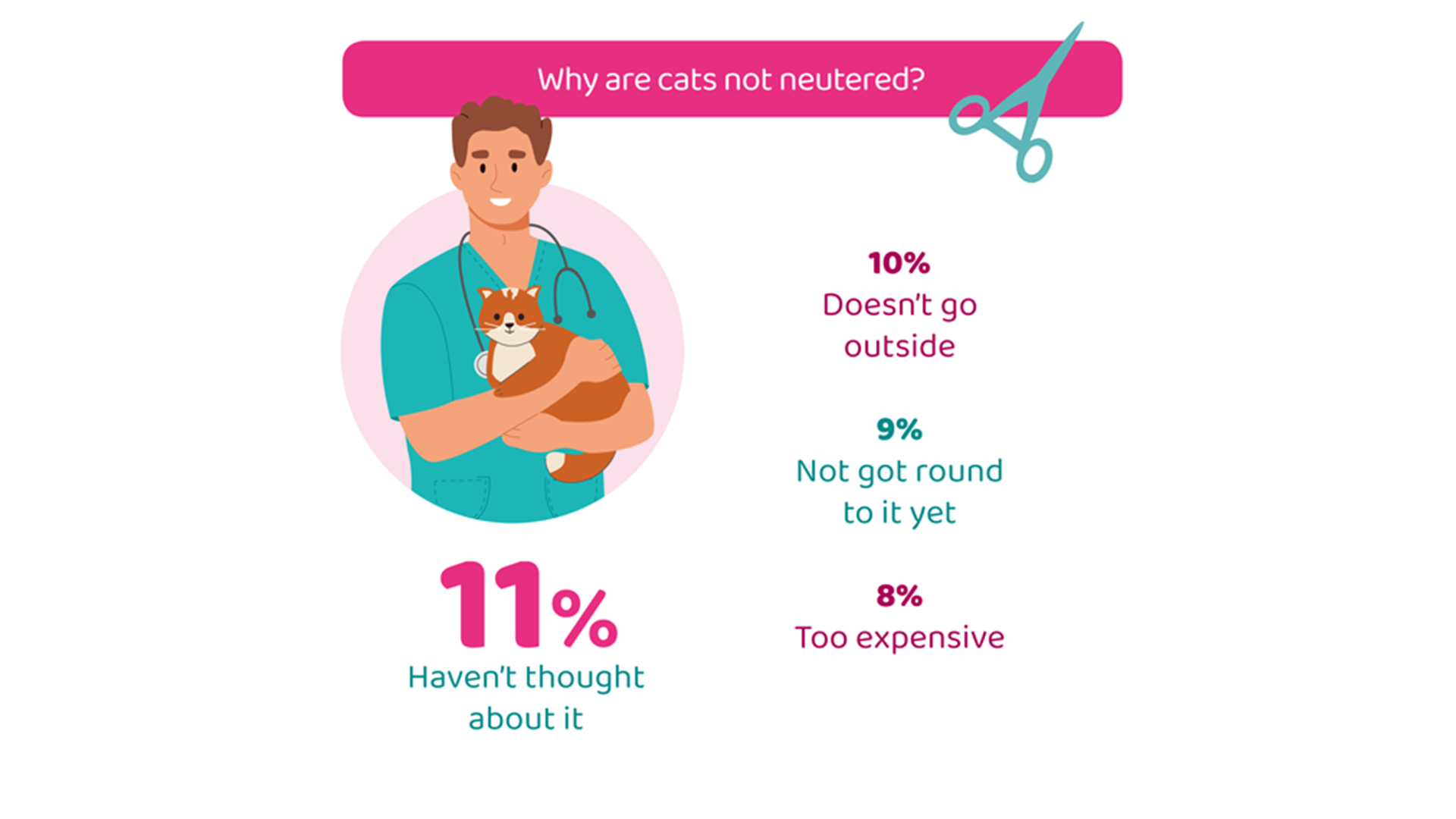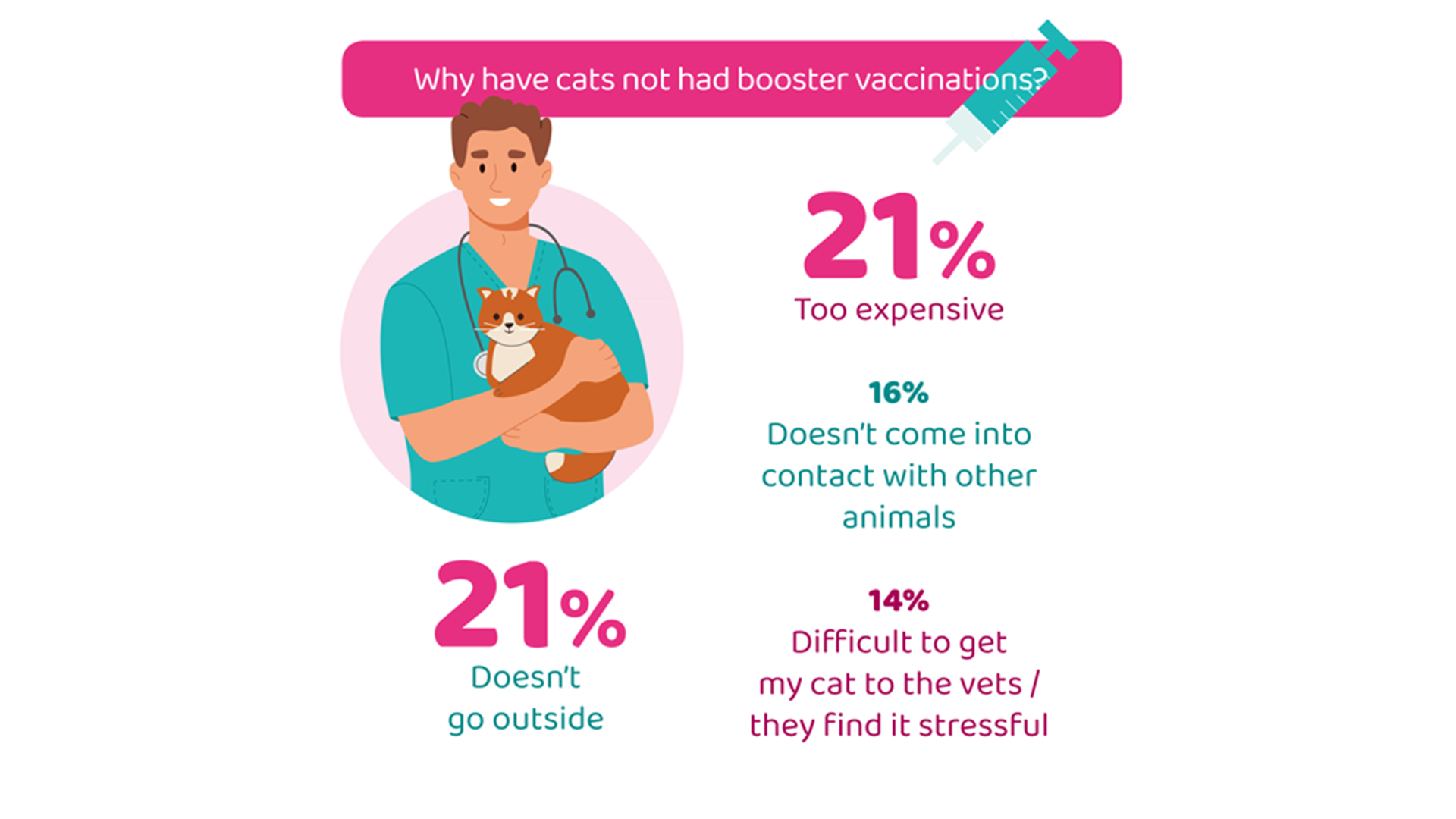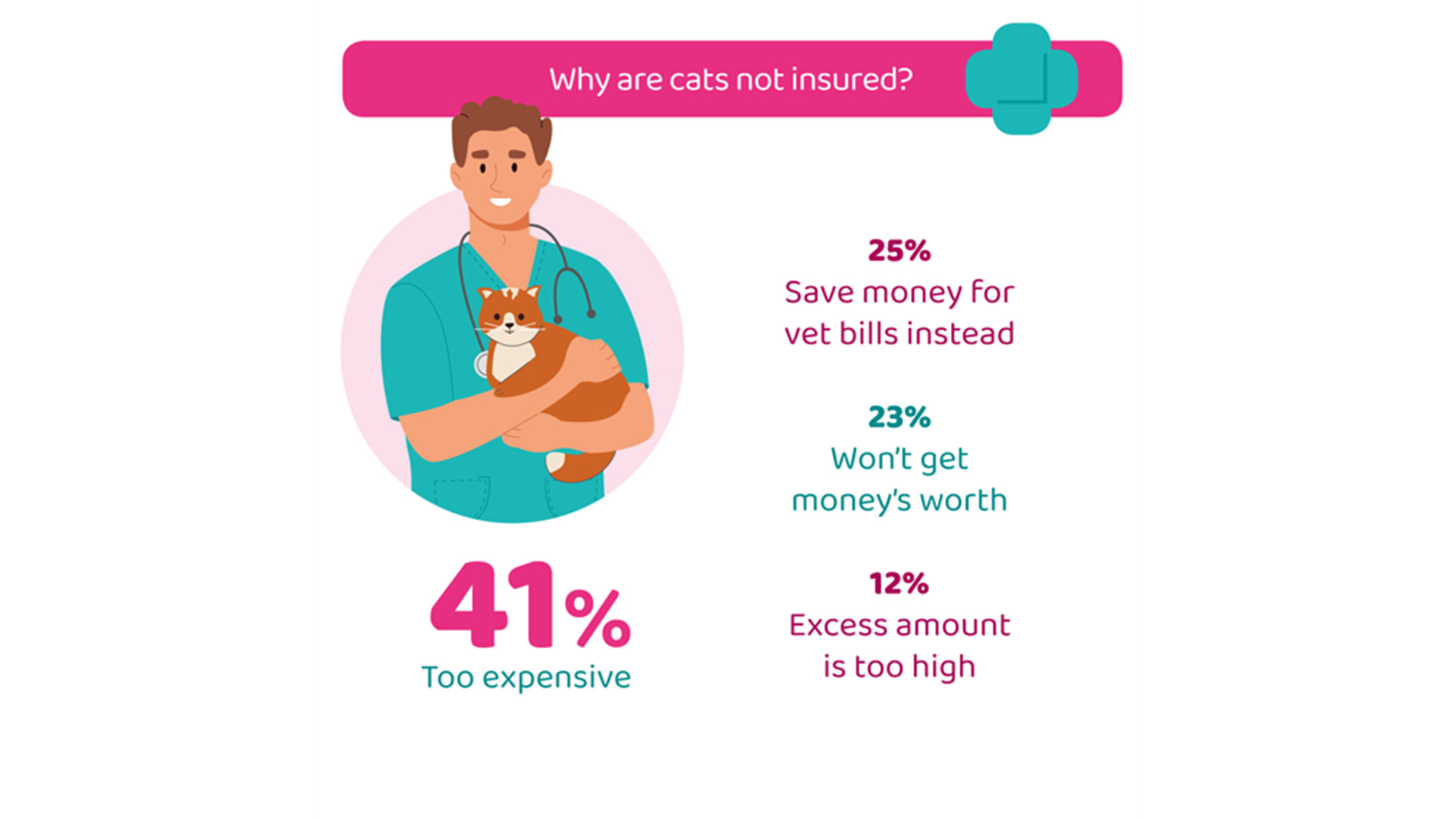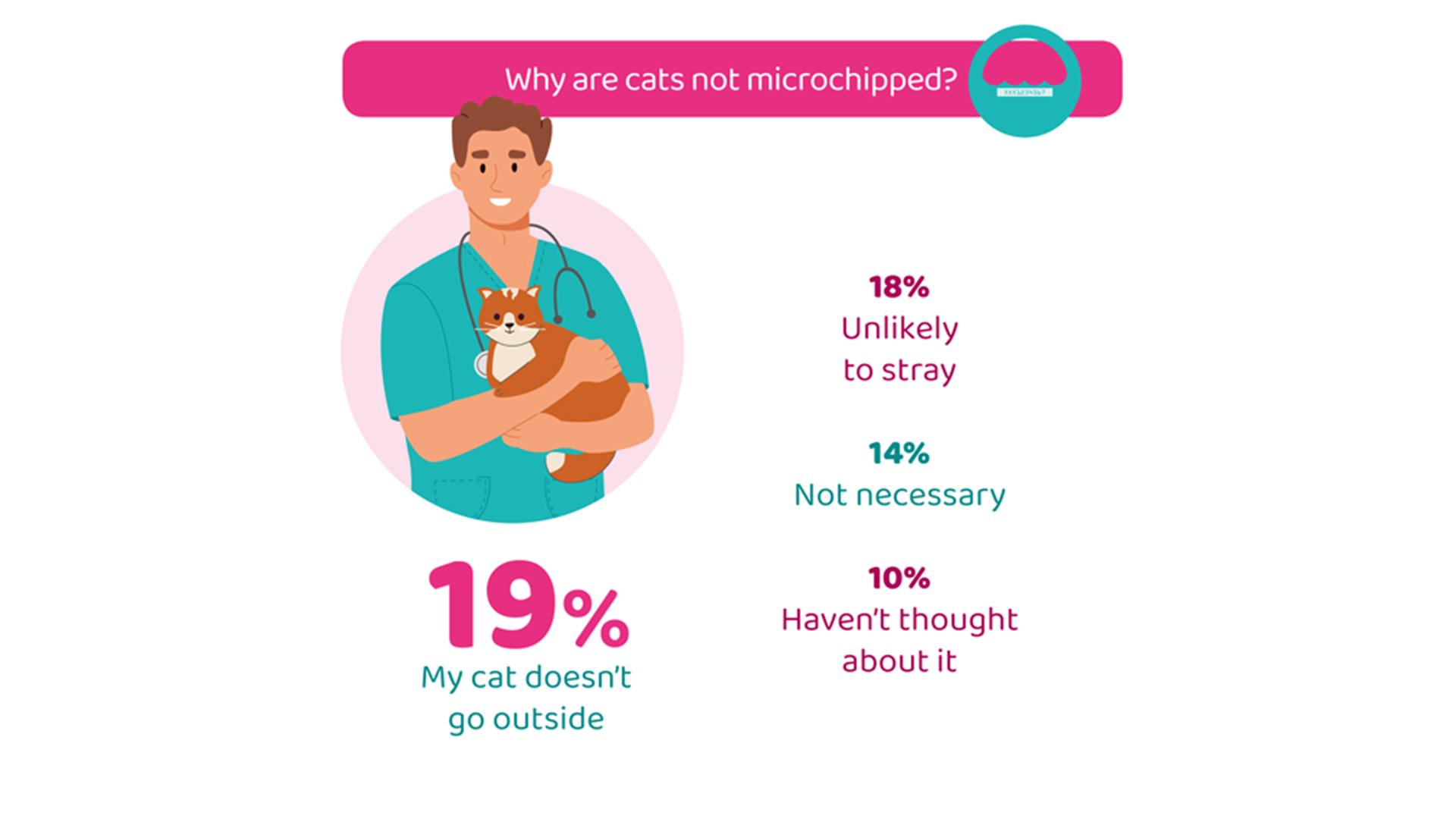Cats
This year, veterinary professionals selected the following as the top welfare issues that need to be addressed for cats:
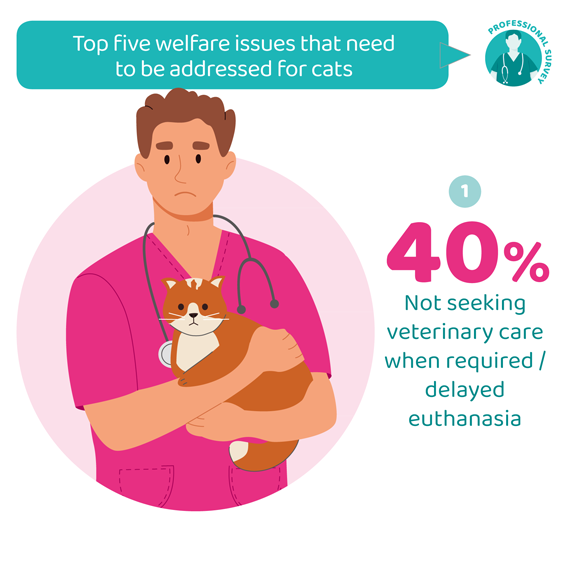
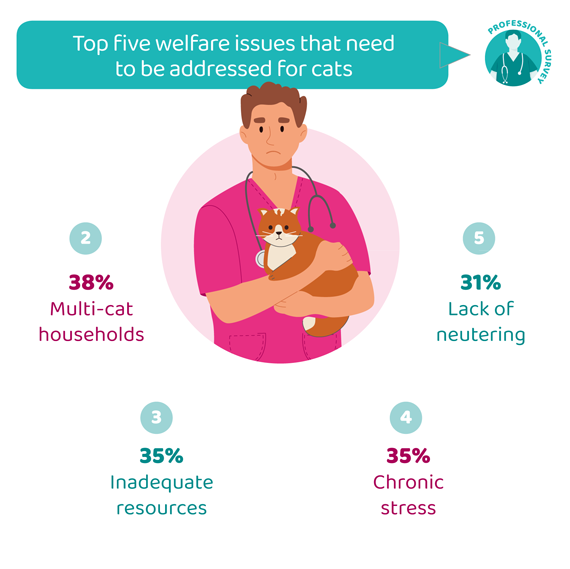
Diet and Obesity
Obesity in cats remains a concern for veterinary professionals, with 26% identifying it as one of the top welfare issues affecting cats in the UK today. Obesity is a risk factor for many serious conditions in cats, including diabetes and urinary tract disease26, so it is vital that owners understand how to keep their pet at a healthy weight. 53% of cat owners don’t know their pet’s current weight, 64% don’t know their cat’s ideal weight and 84% don’t know their cats’ current body condition score (BCS) – these proportions were all higher than for dog owners (32%, 44% and 80% respectively).
75% of cat owners have weighed their pet within the last 12 months – this is a lower proportion than for dog owners (91%). Regular monitoring of a pet’s weight is important to allow early recognition of any changes, both to detect illness and to allow dietary manipulation to avoid obesity27. Of those owners who had not weighed their cat in the last year, 60% said it was because they didn’t feel it was necessary, 21% said it was difficult to weigh their pet at home, 20% said they didn’t want to pay their vet to get their cat weighed, and 15% said it was difficult to get their pet to the vets to be weighed. Many owners find taking their cat to the vets to be a stressful experience28. Initiatives such as the ISFM Cat Friendly Clinic Scheme help address these issues by supporting vets to create a less stressful environment within the veterinary clinic. Educating owners on how to weigh their pets at home, as well as how to recognise other ways of identifying weight gain, such as body condition score, is an essential tool in tackling obesity.
53% of cat owners told us they decide whether their pet is the correct weight by seeking advice from a vet or vet nurse, which is no different from 2022 but is still lower than in 2020 (56%). 38% look at their cat’s body, 27% feel their cat’s body and 20% weigh their cat, which has increased from 17% in 2020.
49% of veterinary professionals say they’ve seen an increase in pet obesity in the last two years, which is lower than in February 2020 when it was 78%. 22% of veterinary professionals said they’d seen a decrease in pet obesity in the last two years (increased from 1% in February 2020). 54% of veterinary professionals who said they’d seen a rise in pet obesity felt it was due to a lack of owners’ understanding of a healthy body shape and weight of a pet, and 40% said it was due to owners not understanding the health implications of obesity. In the 2021 PAW Report, we found that 31% of pet owners did not think overweight pets were more likely to suffer from serious disease and 35% of pet owners did not think overweight pets were less likely to live as long as other pets.
It’s important that owners are able to access accurate, reliable information to help them choose what and how much to feed their pet. We asked owners how they chose what food to give their cat. Cat owners were more likely to stick to the brand they’ve always bought (41%) than dog owners (34%), and more likely to choose a brand that’s easily available (35%) than dog (21%) or rabbit (18%) owners. 23% of cat owners chose their pet’s food by getting advice from a vet or vet nurse, a lower proportion than either dog (32%) or rabbit (33%) owners.
60% of veterinary professionals agreed there is not enough evidence-based information available to help owners understand their pets’ dietary requirements.
We also asked owners how they decided how much food to feed their cat. 19% told us they used common sense (higher than for dog owners at 15%), 15% relied on past experience with their pets (higher when compared to 12% of dog owners), and 13% used packet guidelines (lower than dog owners at 17%). Fewer cat owners (12%) take advice from vets or other veterinary professionals compared to dog (17%) or rabbit (17%) owners. This may possibly be related to the concerns owners have about taking their cat to the vets.
“Obesity and its detrimental effects remains a welfare concern in dogs, cats and rabbits, though it is still frequently overlooked. The PAW Report has again highlighted the need for veterinary practices to increase the education they are providing to their clients about healthy weight and ideal body condition score (BCS).
Without body weight and BCS being used in conjunction, the weight of the pet is just a number, making a judgement of ideal weight more difficult for an owner to identify. Therefore, promoting regular weight checks together with BCS should form a vital part of every visit to the veterinary practice."
Georgia Woods-Lee BSc (Hons) RVN CertCFVHNut VTS (Nutrition), ROYAL CANIN® Weight Management Clinic Nurse, University of Liverpool
Environment
From previous PAW Report data, we know that two in five of the UK’s pet cats live with one or more other cats (42% in 2022). In multi-cat households, it is important that every cat has access to sufficient resources to minimise stress. Inadequate provision of resources runs the risk of creating tensions amongst cats within a home, increasing their likelihood of developing an undesirable behaviour, negatively impacting their welfare and potentially their relationship with their owner.
It is recommended practice to provide one of each resource per cat plus one extra29, spread out around the house to allow cats to avoid each other if they wish to. This year, we found that many cats are still having to share their resources with other cats in their household. In particular, we found that the average number of litter trays in households with two or more cats is 1.49, which could cause stress and increase the risk of cats developing inappropriate toileting behaviours. Veterinary professionals selected multi-cat households (38%) and inadequate resources (35%) as two of the top welfare issues that need addressing for cats, along with chronic stress (35%). 66% of veterinary professionals recommend environmental modification for reducing stress in cats, 64% recommend multiple resources in multi-cat households, and 64% recommend additional litter trays.
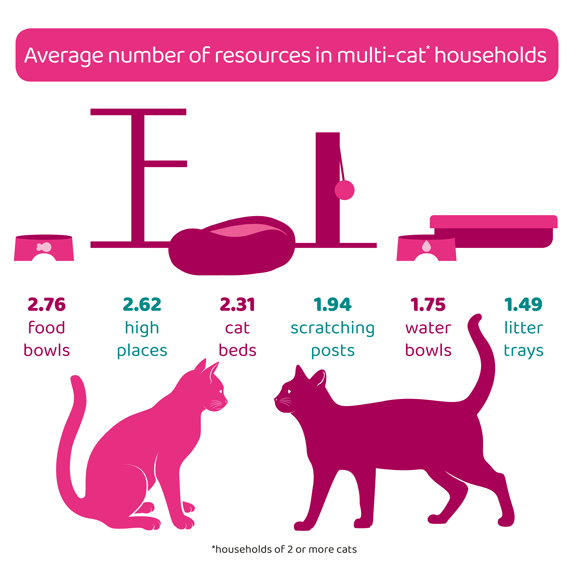
Preventive Health
The rising cost of living has led to concerns that the uptake of preventive healthcare for pets could fall, as owners look at ways to save money. We found that the proportion of owners who reported they had chosen not to provide their cat with preventive healthcare because it was too expensive has not changed from 2022 (8% of owners who haven’t had their cat neutered, 120,000 cats, 21% of owners whose cat hasn’t had regular boosters, 830,000 cats, and 8% of owners who hadn’t had their pet microchipped, 230,000 cats). However, of the 16% of owners whose cat is not currently registered with a vet, the proportion of those saying it was because it is too expensive has increased from 11% in February 2020 to 16% in 2022 and 19% in 2023.
The current recruitment crisis in the veterinary profession may lead to concerns that owners could potentially struggle to access preventive healthcare for their cats. Of the 16% of cat owners whose pet is not currently registered with a vet, 7% (130,000 cats) say this is because practices in their region are not taking on new clients – this is unchanged from 2022. Additionally, some owners reported that their practice wasn’t providing neutering, vaccination, or microchipping procedures (5% of owners who haven’t had their cat neutered, 1% of owners whose cat hasn’t had regular boosters, and 5% of owners who hadn’t had their pet microchipped). Again, these proportions are unchanged from 2022.
This year, 87% of pet cats in the UK are neutered, this is a decrease from 90% in 2021. However, this figure has fluctuated over the last seven years. The most common reason owners selected for not neutering their cat was that they hadn’t thought about it (11%) or that their cat doesn’t go outside (10%). Although many owners may consider neutering their cat primarily for prevention of unwanted litters30, there are important health benefits that also should be considered31. A higher proportion of cats acquired from rescue or rehoming centres were neutered (93%) compared to those acquired from breeders (77%) or family / friends / neighbours (86%).
Neutering cats from four months of age can has the potential to decrease the number of unplanned litters – recent collaborative campaigns across the animal welfare sector have aimed to raise awareness of neutering at four months old among cat owners. 39% of vets routinely recommend neutering cats at four months of age – this is a lower proportion than in 2020, when 58% said this.
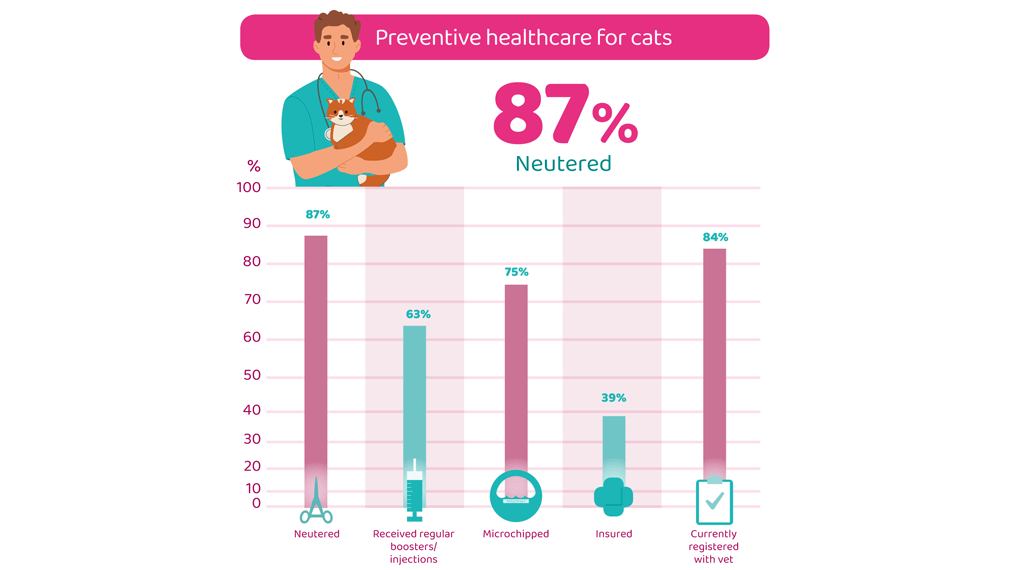
This year, 63% of cats have received regular booster vaccinations, a similar proportion to 2022. 21% of owners whose cats haven’t had booster vaccinations told us it was because their cat didn’t go outside, 21% stated it was too expensive and 16% that their cat doesn’t come into contact with other animals. 14% said their cat had not received booster vaccinations because it was difficult to get their pet to the vets, or their cat found it stressful, a higher proportion than for dog owners (7%).
75% of cats are microchipped – after a continual increase from 46% in 2011, this trend appears to have slowed since February 2020, when 74% of cats were microchipped. 67% of cat owners are unaware that legislation due to be introduced in 2024 will mean that all cats must be microchipped. It appears that a significant amount of work is needed in the next 12 months to raise awareness of this legislative change.
It is important that owners are aware of which database their pet’s microchip is registered to so they are able to update contact details as needed – 60% of veterinary professionals told us that they had experienced owners’ details not being up to date on microchip databases. 62% of cat owners (5.1 million cats) whose cat has been microchipped do not know what database their cat’s microchip is registered on, which was slightly higher than dog owners (58%). A small proportion (less than 1%) say their cat is registered on a database that is not on the list of those meeting government standards, a similar proportion to dog owners (2%).
51% of veterinary professionals had seen pets who were microchipped but not registered to any databases, 40% reported it was difficult to search some databases, and 37% said it was difficult to get owner details from some of the databases. 28% had seen pets registered on databases which are not on the official government list, and 17% had seen pets who were registered on multiple databases. A centralised microchip database system would help to reduce many of the current problems.
The uptake of pet insurance amongst cat owners (39%) remains lower than for dogs (61%). Of cat owners who had not insured their cat, 41% told us this was because insurance is too expensive, 23% didn’t think they would get their money’s worth and 25% save money for vet bills instead.
Key findings about cats from our 2023 PAW Report
 Video found at youtu.be/_uYw7ItCs0k
Video found at youtu.be/_uYw7ItCs0k

Footnotes
26 Teng KT, McGreevy PD, Toribio JALML, Raubenheimer D, Kendall K, Dhand NK. Associations of body condition score with health conditions related to overweight and obesity in cats. J Small Anim Pract. 2018 Jul 22
27 Brooks, D., Churchill, J., Fein, K., Linder, D., Michel, K.E., Tudor, K., Ward, E. and Witzel, A., (2014). 2014 AAHA weight management guidelines for dogs and cats. Journal of the American Animal Hospital Association, 50(1), pp.1-11
28 Riemer, S., Heritier, C., Windschnurer, I., Pratsch, L., Arhant, C., & Affenzeller, N. (2021). A review on mitigating fear and aggression in dogs and cats in a veterinary setting. Animals, 11(1), 158
29 Ellis, S. L., Rodan, I., Carney, H. C., Heath, S., Rochlitz, I., Shearburn, L. D., ... & Westropp, J. L. (2013). AAFP and ISFM feline environmental needs guidelines. Journal of feline medicine and surgery, 15(3), 219-230
30 Wongsaengchan, C., & McKeegan, D. E. (2019). The views of the UK public towards routine neutering of dogs and cats. Animals, 9(4), 138
31 Yates, D., & Leedham, R. (2019). Prepubertal neutering in cats and dogs. In Practice, 41(7), 285-298

